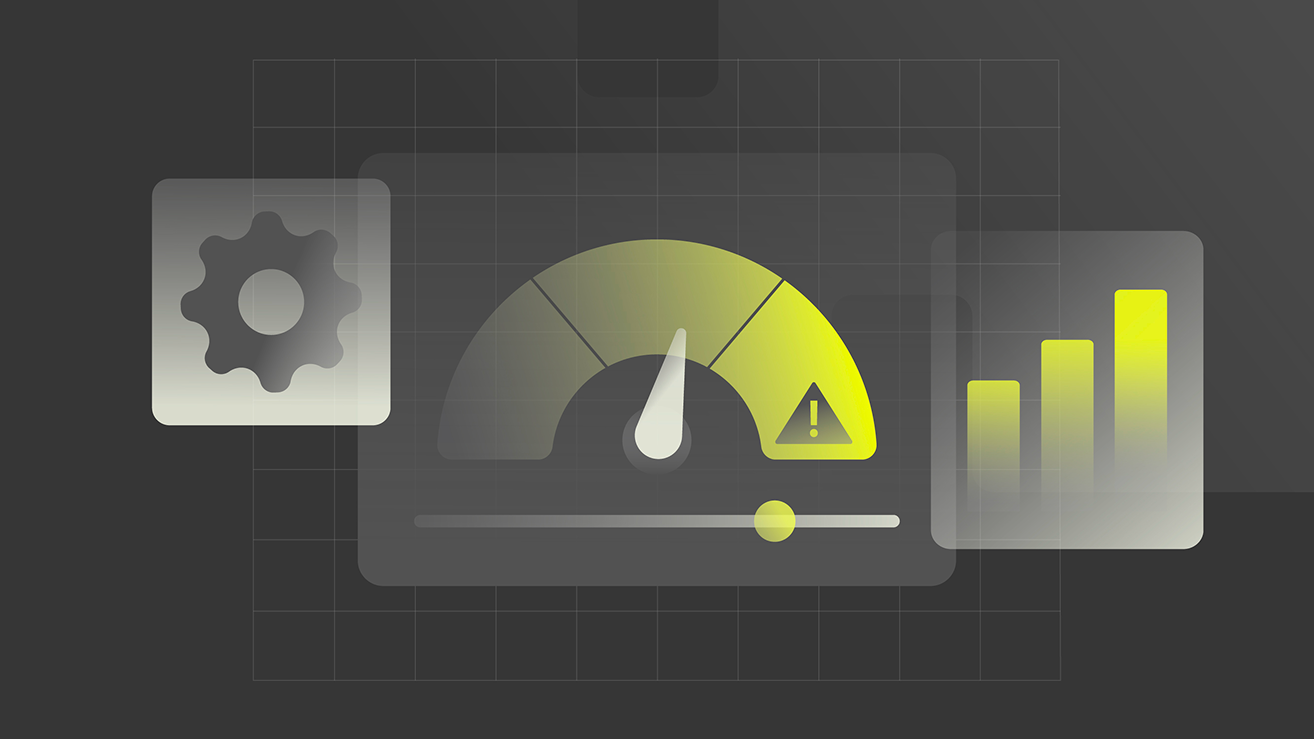
Key Takeaways
Automated risk management uses AI to transform how businesses identify, assess, and mitigate risks.
- What it does: Instead of relying on periodic manual assessments, AI-powered systems provide continuous monitoring. By analyzing data from various sources, these systems can proactively identify potential risks (financial fraud, cybersecurity threats, etc.).
- The business impact: This proactive, data-driven approach enables organizations to manage risk more effectively and build greater operational resilience.
- The key benefit: It allows teams to prioritize their efforts based on the AI’s scoring of risks.
For large enterprises, the challenge of managing risk isn’t static; it’s a dynamic, ever-evolving landscape. Traditional methods of risk identification and mitigation, often reliant on manual checks and fragmented tools, simply can’t keep pace with the speed and complexity of today’s global operations. What’s needed is a transformative approach: one that leverages intelligent, autonomous systems for automated risk assessment. This shift moves beyond basic automation, leading to continuous identification, evaluation, and response to threats across the entire organization.
The objective isn’t merely to reduce human effort; it’s about building an enterprise-grade AI framework that ensures continuous compliance, significantly reduces financial exposure, and provides real-time visibility into an evolving risk landscape. This article will explore how organizations can achieve this by embracing advanced AI, particularly focusing on how some platforms empower proactive, resilient risk management frameworks through natural language process automation.
The Evolving Landscape of Enterprise Risk
Modern enterprises face a multitude of risks, from cyber threats and regulatory non-compliance to supply chain disruptions and financial fraud. The sheer volume of data, coupled with intricate interdependencies across business units, makes comprehensive risk management a formidable task. Relying on periodic audits or siloed departmental efforts creates blind spots and leaves organizations vulnerable.
Effective risk management today demands a continuous, integrated approach. It requires the ability to sift through vast amounts of structured and unstructured data, identify subtle anomalies, predict potential failures, and trigger immediate, intelligent responses. This is where the power of an intelligent automated risk assessment platform becomes indispensable.
What Is Automated Risk Assessment?
Automated risk assessment employs artificial intelligence and natural language processing to continuously identify, evaluate, and prioritize potential threats and vulnerabilities within an organization’s operations, financial systems, and compliance frameworks. Unlike manual methods, it leverages intelligent automation to process vast amounts of data, providing real-time insights and proactive risk mitigation strategies.
This goes beyond simple rule-based automation. True automated risk assessment involves sophisticated AI reasoning that can understand context, learn from historical data, and even handle exceptions intelligently. It’s about building systems that can think and adapt, not just follow predefined scripts. For instance, in finance, this could mean an AI system automatically flagging unusual transaction patterns indicative of fraud, or in operations, predicting equipment failure based on sensor data and maintenance logs. The goal is to move from reactive crisis management to proactive risk anticipation, greatly enhancing organizational resilience.
Automated Risk Assessment with Kognitos
Kognitos empowers automated risk assessment through:
- Natural Language Process Automation: Kognitos uses English as code, bridging the gap between IT and business users. Business leaders can describe their risk assessment processes in plain English, and the platform translates these into executable automations. This means tribal knowledge and system expertise are extracted into documented, automated workflows, creating a dynamic system of record for business operations with full auditability and explainability.
- Neurosymbolic AI with No Hallucinations: Critical for risk management, Kognitos’ cutting-edge neurosymbolic architecture ensures processes are followed precisely, eliminating AI hallucinations by design. This provides robust AI governance and control, guaranteeing that automated risk assessments are accurate and reliable.
- Comprehensive AI Governance: The Kognitos platform is built for enterprise-grade deployment. Its design ensures that automated processes adhere to defined parameters, providing the oversight and control necessary for sensitive risk functions.
- Patented Process Refinement Engine: Risk landscapes are constantly changing. Kognitos addresses this with its patented Process Refinement Engine. By learning from human interactions—particularly through the Guidance Center, where any exception or deviation pulls in human guidance—Kognitos continually updates automated processes. This ensures the system of record stays accurate and aligned with business evolution, making your automated risk management framework truly adaptive.
- Support for Any Structured and Unstructured Data Types: Risk assessment involves analyzing a vast array of data. Kognitos seamlessly integrates with structured data in databases and hundreds of enterprise applications, as well as unstructured data found in emails, documents, voice mails, texts, and images. This comprehensive data handling capability is crucial for a complete view of potential risks.
By focusing on natural language process automation and intelligent exception handling, Kognitos automates the underlying, interconnected processes of risk assessment. This makes it distinct from rigid, programming-dependent solutions, ensuring that your automated risk assessment tools are both powerful and flexible.
Key Steps to Automate Risk Assessment with Kognitos
Implementing automated risk assessment with Kognitos involves a strategic approach that leverages its unique capabilities:
| Step | Description | The Kognitos Advantage |
| 1. Define Scope and Objectives | Clearly identify the specific risk areas and processes targeted for automation. | Business users define this directly in natural language, ensuring alignment with organizational goals. |
| 2. Integrate Data Sources | Connect to all relevant data, both structured and unstructured, across the enterprise. | Supports any data type, from enterprise applications to documents and emails, providing a unified view for automated risk assessment. |
| 3. Design Automated Workflows | Map out the “if-then” logic for identifying risks, assessing their impact, and triggering responses. | English as code enables rapid design and iteration by business and IT teams working collaboratively. Pre-built workflows can be deployed or customized. |
| 4. Implement Intelligent Exception Handling | Establish clear protocols for human intervention when AI encounters ambiguities or new scenarios. | The Guidance Center ensures human-in-the-loop validation, which the Process Refinement Engine learns from for continuous improvement. |
| 5. Continuous Monitoring and Refinement | Maintain ongoing oversight of the automated processes and adapt them as risk factors evolve. | Patented Process Refinement Engine and automatic agent regression testing ensure automations remain current and effective. |
These steps demonstrate how Kognitos enables organizations to go beyond basic task automation, moving towards truly intelligent automating risk management.
Realizing the Benefits of Automated Risk Assessment
The adoption of an advanced platform for automated risk assessment yields significant advantages for large enterprises:
- Enhanced Accuracy and Consistency: AI eliminates human error in data processing and analysis, providing consistent and objective risk evaluations. Neurosymbolic AI guarantees processes are followed precisely, eliminating hallucinations.
- Real-time Visibility and Proactive Response: Continuous monitoring means risks are identified as they emerge, allowing for immediate mitigation before they escalate into major incidents. This is key for automating security risk assessments.
- Reduced Operational Costs: Automating repetitive, manual tasks frees up highly skilled personnel to focus on strategic risk mitigation and innovation, rather than routine checks.
- Improved Compliance and Governance: Automated systems can continuously monitor adherence to regulatory requirements, significantly reducing the risk of non-compliance penalties. Kognitos’ built-in AI governance ensures auditability.
- Scalability and Flexibility: As the business grows or new risk factors emerge, the automated system can scale to accommodate increased data volumes and adapt to new process requirements with ease.
- Deeper Insights: AI can uncover subtle correlations and patterns in vast datasets that human analysts might miss, leading to more profound insights into potential vulnerabilities.
These benefits collectively contribute to a more resilient, agile, and secure enterprise. By embracing automated risk management, businesses can transform risk from a burden into a strategic advantage.
Best Practices for Automated Risk Management
Achieving success with automated risk assessment involves adhering to several key practices:
- Adopt an Enterprise-Wide View: Avoid siloed automation efforts. A unified platform allows for a holistic view of risks across all departments and processes. Kognitos supports broad use cases, reducing tool sprawl.
- Prioritize Human-in-the-Loop: While automation is powerful, human oversight remains crucial for complex exceptions and strategic decision-making. Ensure your solution incorporates intelligent human guidance.
- Ensure Data Quality and Accessibility: The effectiveness of any automated system hinges on the quality and accessibility of the data it processes. Invest in data governance and integration. Kognitos handles diverse data types seamlessly.
- Focus on Continuous Improvement: Risk management is an ongoing process. Your automation solution should be capable of continuous learning and refinement based on new data and human feedback. The Process Refinement Engine in Kognitos is designed for this.
- Foster Business-IT Collaboration: Success depends on close partnership between business leaders, who understand the risks, and IT, who implement the technical solutions. English as code in Kognitos fosters this synergy.
- Start Small, Scale Strategically: Begin with a pilot project in a well-defined area, demonstrate success, and then gradually expand the scope of automation across the organization.
These practices, when combined with the right platform, create a robust framework for automating risk management effectively.
The Future of Risk Management is Proactive, and Adaptive
The future of risk management is intelligent, proactive, and adaptive. It moves beyond traditional, reactive measures to embrace the full potential of AI-driven automated risk assessment. For large enterprises, this isn’t just about efficiency; it’s about competitive advantage and survival in an increasingly complex and unpredictable world.
Kognitos, with its unique blend of natural language process automation, neurosymbolic AI, comprehensive governance, and a patented Process Refinement Engine, is positioned to redefine how organizations approach risk. It empowers business users, brings IT and business onto the same page, and ensures that risk management frameworks are not just robust, but also continuously learning and evolving. By choosing the right platform, enterprises can transition from merely reacting to threats to intelligently anticipating and mitigating them, building an unparalleled level of organizational resilience.
Discover the Power of Kognitos
Our clients achieved:
- 97%reduction in manual labor cost
- 10xfaster speed to value
- 99%reduction in human error
AI for sales refers to the application of artificial intelligence technologies to enhance and automate various aspects of the sales process. This includes tasks such as lead generation, qualification, customer relationship management, forecasting, contract management, and post-sales support. It moves beyond simple automation to intelligent decision-making and continuous process improvement.
AI significantly enhances sales forecasting by analyzing vast amounts of historical sales data, market trends, customer behavior, and external factors. Machine learning algorithms can identify complex patterns and correlations that human analysts might miss, leading to more accurate predictions of future sales performance. This helps businesses optimize resource allocation and strategic planning.
Selecting the best AI tool for sales depends on an organization’s specific needs and existing tech stack. For comprehensive enterprise-grade automation that handles both front-end sales support and complex back-office operations, platforms like Kognitos are highly effective. Kognitos leverages natural language processing and neurosymbolic AI to automate end-to-end sales processes, manage exceptions, and continuously learn from human interactions, offering a unified and highly adaptable solution.
AI can be used in the sales process in numerous ways: from automating lead nurturing and qualification, personalizing customer communications, and generating dynamic proposals, to streamlining contract approvals and managing order fulfillment. It also plays a critical role in providing sales teams with real-time insights, predicting customer needs, and ensuring compliance throughout the sales cycle.
Generative AI for sales primarily focuses on creating new content or data. This includes generating personalized email drafts, crafting compelling sales copy for marketing campaigns, creating product descriptions, summarizing customer interactions, or even simulating sales scenarios for training purposes. It assists in content creation and communication, making sales outreach more efficient and tailored.
Types of AI in sales include:
- Predictive AI: Used for sales forecasting, lead scoring, and identifying potential customer churn.
- Generative AI: For content creation, such as personalized emails or sales scripts.
- Conversational AI: Powering chatbots and virtual assistants for customer engagement and support.
- Prescriptive AI: Recommending the best next actions for sales reps based on data analysis.
- Agentic AI: Autonomous systems that can perceive, reason, and act to achieve complex sales goals, often managing end-to-end processes across various departments.
The future of AI in sales involves increasingly autonomous, intelligent, and integrated systems. Agentic AI will take on more end-to-end process ownership, learning and adapting in real-time. We’ll see deeper personalization, more accurate forecasting, and a seamless flow of information between sales, marketing, and operations. The human role will evolve to focus on high-value strategy, relationship building, and creative problem-solving, supported by highly efficient AI-driven operations.
The benefits of using AI in sales include increased sales productivity, enhanced customer experience, improved data accuracy and insights, reduced operational costs, and faster sales cycles. By automating routine tasks and providing intelligent support, AI allows sales teams to focus on strategic activities, leading to higher revenue and greater efficiency.
Challenges of using AI in sales can include ensuring data quality and integration with existing systems, managing organizational change and user adoption, addressing concerns about data privacy and security, and selecting an AI solution that provides clear ROI and avoids “black box” outcomes. Overcoming these requires careful planning, robust technology, and a focus on measurable business outcomes.
Automated risk assessment uses artificial intelligence and natural language processing to continuously identify, evaluate, and prioritize potential threats and vulnerabilities within an organization’s operations, financial systems, and compliance frameworks. Unlike manual methods, it leverages intelligent automation to process vast amounts of data, providing real-time insights and proactive risk mitigation strategies. Kognitos takes this a step further by automating the underlying processes of risk assessment through natural language, ensuring comprehensive analysis and intelligent exception handling.
Automating risk assessment involves several key steps. First, define the scope and objectives, identifying critical assets and potential risk areas. Next, integrate relevant data sources, which can include structured data from databases and applications, and unstructured data like emails, documents, and reports. Then, configure the AI to analyze this data, identify patterns, anomalies, and potential risks. With Kognitos, this configuration happens through natural language, allowing business users to define processes in plain English. Finally, establish continuous monitoring and a human-in-the-loop mechanism for intelligent exception handling, ensuring the system learns and refines its processes over time. This iterative refinement is a core capability of Kognitos’ Process Refinement Engine.
The benefits of automated risk assessment are substantial. It significantly enhances accuracy and consistency, reduces manual errors, and frees up human capital for strategic tasks. Organizations gain real-time visibility into their risk posture, enabling proactive responses to emerging threats. It also improves compliance by ensuring continuous adherence to regulatory requirements and reduces financial exposure through early identification and mitigation of risks. With Kognitos, these benefits are amplified by an AI that doesn’t hallucinate, providing dependable insights for critical decision-making.
Effective practices in automating risk assessment include embracing an enterprise-wide approach that integrates various data silos, fostering collaboration between IT and business units, and prioritizing continuous monitoring over periodic reviews. It’s crucial to select an AI platform that supports comprehensive AI governance and can handle both structured and unstructured data seamlessly. The Kognitos platform exemplifies these practices by providing a unified solution that empowers business users to define and refine automated processes using natural language, ensuring alignment with evolving business needs and regulatory landscapes.
Automated risk refers to the capability of systems to identify, analyze, and respond to potential threats and vulnerabilities without direct human intervention at every step. This involves using advanced technologies like AI and natural language processing to monitor operational data, detect anomalies, and trigger appropriate mitigation actions. It’s about shifting from reactive risk management to a proactive, continuous posture, where risks are anticipated and addressed before they escalate.
An automated assessment tool is a software solution designed to streamline and enhance the process of evaluating various organizational aspects, including security vulnerabilities, compliance adherence, or operational efficiency. For risk, these tools leverage AI to analyze data, identify patterns, and flag potential issues. Kognitos, as an enterprise-grade AI platform, serves as a powerful automated assessment tool for risk, enabling organizations to define and execute complex risk assessment processes using natural language, integrating with diverse data sources, and continuously learning from human guidance.








